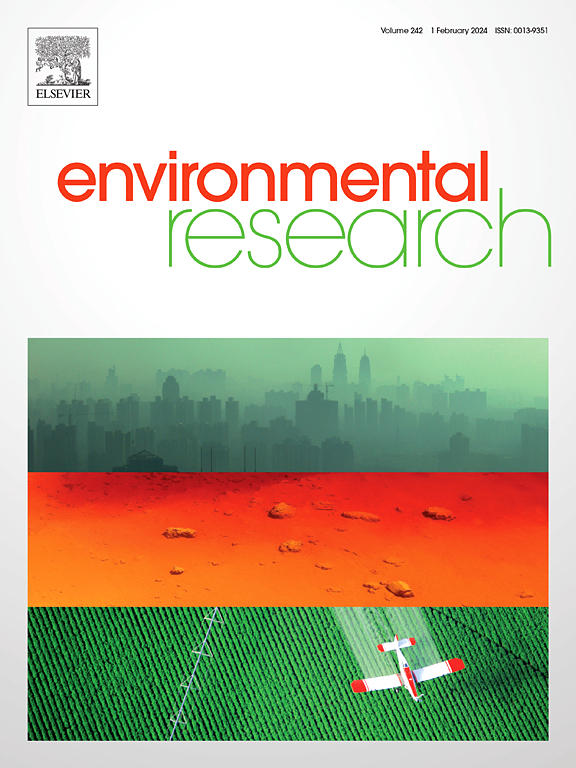卡拉胶生物炭-橄榄石复合材料提纯铜(II): K (I)、Mg (II)、Fe (II/ III)和Si (IV)的协同效应
IF 7.7
2区 环境科学与生态学
Q1 ENVIRONMENTAL SCIENCES
引用次数: 0
摘要
生物炭是一种很好的环境污染物吸附剂。然而,它们的适用性受到特定缺陷的阻碍,包括吸附能力有限、选择性不足和可重复使用性低。例如,卡拉胶胶纯生物炭(BC CA300)由于其表面官能团结合较弱,对Cu (II)的吸附性能较差。物理改性消耗能源,而化学改性大量使用化学品,造成环境危害。本文研制了一种选择性高效吸附Cu (II)的改性剂。采用一锅水热炭化(HTC)技术在BC CA300表面接枝橄榄石矿物(Mg, Fe)2 SiO4。从吸附动力学、等温线、热力学以及DFT计算和静电势(ESP)映射的角度研究了工程生物炭(BC CAOL)对K(I)、Mg (II)、Fe (II)、Fe (III)和Si (IV)的协同效应。通过BET、FTIR、XPS、SEM-EDS对BC CA300和BC CAOL的表面结构进行了检测和比较。结果表明,工程生物炭吸附量为340.98 mg g−1,是纯生物炭吸附量(72.51 mg g−1)的4.7倍。工程生物炭的吸附能是纯生物炭的2.5倍。协同效应表现为以下顺序:K >;菲比;阿比;如果比;毫克。因此,Cu (II)的吸附机制主要是由沉淀驱动的;络合比;螯合在离子交换,除了孔填充机制。这项研究强调了胶矿物复合生物炭作为一种绿色、有效和选择性的Cu (II)负载废水净化替代品的潜力。本文章由计算机程序翻译,如有差异,请以英文原文为准。

Superior Cu (II) purification using carrageenan biochar-olivine composite: Synergistic effects of K (I), Mg (II), Fe (II/ III), and Si (IV)
Biochar is a remarkable adsorbent for environmental pollutants. However, their applicability is hindered by specific deficiencies, including restricted adsorption capacity, inadequate selectivity, and low reusability. For instance, carrageenan gum pure biochar (BC CA300) exhibits inadequate Cu (II) adsorption performance owing to the weakly binding surface functional groups. Physical modification consumes energy, while chemical modification heavily uses chemicals, causing environmental harm. Herein, a novel modifying agent was developed that can selectively and efficiently adsorb Cu (II). The BC CA300 surface was grafted with olivine mineral (Mg, Fe)2 SiO4 through a one-pot hydrothermal carbonization (HTC) technique. The engineered biochar (BC CAOL) was investigated for the synergistic effect of K(I), Mg (II), Fe (II), Fe (III), and Si (IV) from the viewpoints of adsorption kinetics, isotherm, and thermodynamics alongside DFT calculations and electrostatic potential (ESP) mapping. The surface structure of BC CA300 and BC CAOL was examined and compared through BET, FTIR, XPS, and SEM-EDS. It was found that engineered biochar adsorption capacity (340.98 mg g−1) was 4.7 times greater than that of pure biochar (72.51 mg g−1). The adsorption energy of engineered biochar is 2.5 times greater than that of pure biochar. The synergistic effect is indicative of the following sequence: K > Fe > O > Si > Mg. Hence, the Cu (II) adsorption mechanism is primarily driven by precipitation > complexation > chelation > ion exchange, beside the pore-filling mechanism. This research highlights the potential of gum-mineral composite biochar as a green, effective, and selective alternative for Cu (II)-laden wastewater decontamination.
求助全文
通过发布文献求助,成功后即可免费获取论文全文。
去求助
来源期刊

Environmental Research
环境科学-公共卫生、环境卫生与职业卫生
CiteScore
12.60
自引率
8.40%
发文量
2480
审稿时长
4.7 months
期刊介绍:
The Environmental Research journal presents a broad range of interdisciplinary research, focused on addressing worldwide environmental concerns and featuring innovative findings. Our publication strives to explore relevant anthropogenic issues across various environmental sectors, showcasing practical applications in real-life settings.
 求助内容:
求助内容: 应助结果提醒方式:
应助结果提醒方式:


